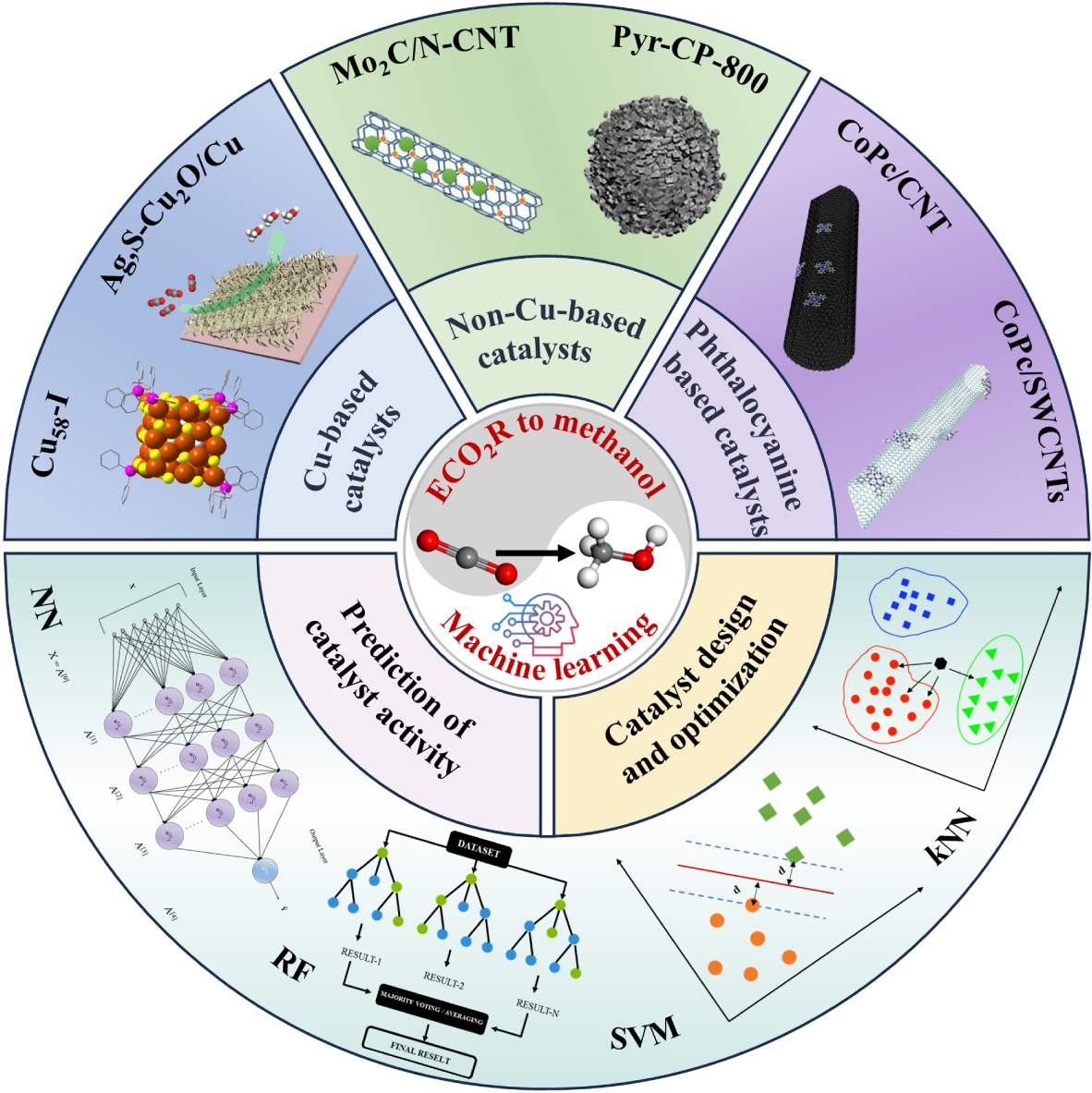 PDF(16953 KB)
PDF(16953 KB)


Electrocatalytic CO2 Reduction to Methanol and Machine Learning Assistance
Sun Ruyu, Qi Man, Zhao Yawen, Lv Yongli, Wang Li, Yan Wei
Prog Chem ›› 2025, Vol. 37 ›› Issue (9) : 1274-1289.
 PDF(16953 KB)
PDF(16953 KB)
 PDF(16953 KB)
PDF(16953 KB)
Electrocatalytic CO2 Reduction to Methanol and Machine Learning Assistance
With the increasing global emphasis on carbon dioxide emissions reduction, electrocatalytic carbon dioxide reduction (ECO2R) to methanol has garnered significant attention within the context of carbon neutrality. However, existing ECO2R catalysts still suffer from limitations in activity, selectivity, and stability, thereby constraining their practical applications. This underscores the urgent need for the development of highly efficient catalysts, which remains a central research focus in this field. Traditional catalyst design predominantly relies on trial-and-error approaches, which are inherently inefficient. Therefore, novel strategies are required to accelerate catalyst discovery and optimization. With the rapid advancement of artificial intelligence, machine learning has emerged as a powerful tool to drive catalyst development. This review systematically summarizes the reaction mechanisms underlying ECO2R to methanol and highlights recent advancements in catalyst research, encompassing Cu-based, non-Cu-based, and phthalocyanine-based catalysts. Furthermore, the fundamental framework of machine learning applications in this domain is introduced, covering key stages from data acquisition to model validation. Particular emphasis is placed on machine learning-driven predictions of catalytic activity, catalyst design, and performance optimization. Although machine learning has made remarkable progress in ECO2R research, there are still several challenges, including data scarcity, insufficient model interpretability, and the lack of a universal prediction framework. Future research should focus on the establishment of high-quality catalyst databases, enhancement of model interpretability, and improvement of generalization capabilities. This review aims to provide a comprehensive perspective on ECO2R catalyst design while emphasizing the pivotal role of machine learning in facilitating breakthroughs in this field.
1 Introduction
2 Reaction mechanism of electrochemical carbon dioxide reduction to methanol
2.1 Reduction of carbon dioxide to two‑electron products
2.2 Further conversion of carbon monoxide intermediates
3 Electrocatalysts for the reduction of carbon dioxide to methanol
3.1 Copper‑based catalysts
3.2 Non‑copper‑based catalysts
3.3 Phthalocyanine‑based catalysts
3.4 Design principles and performance regulation of catalysts
4 Machine learning-assisted electrocatalytic reduction of carbon dioxide to methanol
4.1 Basic procedures of machine learning application
4.2 Machine learning empowering the design of carbon dioxide to methanol catalysts
5 Challenges and prospects
5.1 Improve catalyst stability
5.2 In-depth analysis of reaction mechanisms
5.3 Optimize reactor structure
5.4 Machine learning-assisted catalyst design

electrocatalytic CO2 reduction / methanol / machine learning / high-throughput screening / catalyst design
| [1] |
|
| [2] |
|
| [3] |
|
| [4] |
|
| [5] |
|
| [6] |
|
| [7] |
|
| [8] |
|
| [9] |
|
| [10] |
|
| [11] |
|
| [12] |
|
| [13] |
|
| [14] |
|
| [15] |
|
| [16] |
|
| [17] |
|
| [18] |
|
| [19] |
|
| [20] |
|
| [21] |
|
| [22] |
|
| [23] |
|
| [24] |
|
| [25] |
|
| [26] |
|
| [27] |
|
| [28] |
|
| [29] |
|
| [30] |
|
| [31] |
|
| [32] |
|
| [33] |
|
| [34] |
|
| [35] |
|
| [36] |
|
| [37] |
|
| [38] |
|
| [39] |
|
| [40] |
|
| [41] |
|
| [42] |
|
| [43] |
|
| [44] |
|
| [45] |
|
| [46] |
|
| [47] |
|
| [48] |
|
| [49] |
|
| [50] |
|
| [51] |
|
| [52] |
|
| [53] |
|
| [54] |
|
| [55] |
|
| [56] |
|
| [57] |
|
| [58] |
|
| [59] |
|
| [60] |
|
| [61] |
|
| [62] |
|
| [63] |
|
| [64] |
|
| [65] |
|
| [66] |
|
| [67] |
|
| [68] |
|
| [69] |
|
| [70] |
|
| [71] |
|
| [72] |
|
| [73] |
|
| [74] |
|
| [75] |
|
| [76] |
|
| [77] |
( 李歌, 马子然, 闾菲, 彭胜攀, 佟振伟. 材料导报, 2025, 39(01): 160).
|
| [78] |
|
| [79] |
|
| [80] |
|
| [81] |
|
| [82] |
|
| [83] |
|
| [84] |
|
| [85] |
|
| [86] |
|
| [87] |
|
| [88] |
|
/
| 〈 |
|
〉 |